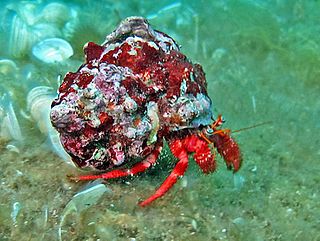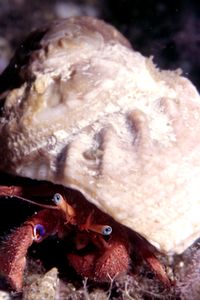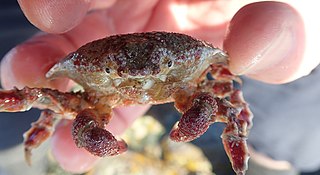
Hermit crabs are anomuran decapod crustaceans of the superfamily Paguroidea that have adapted to occupy empty scavenged mollusc shells to protect their fragile exoskeletons. There are over 800 species of hermit crab, most of which possess an asymmetric abdomen concealed by a snug-fitting shell. Hermit crabs' soft (non-calcified) abdominal exoskeleton means they must occupy shelter produced by other organisms or risk being defenseless.

The halloween hermit crab, also known as the striped hermit crab or orange-legged hermit crab, is a brightly colored aquatic hermit crab of the family Diogenidae. Besides its ability to routinely clean algae in aquaria, the halloween hermit crab's festive striped coloration also appeals to enthusiasts; it is considered the most brightly colored hermit crab in normal aquarium use.

The Diogenidae are a family of hermit crabs, sometimes known as "left-handed hermit crabs" because in contrast to most other hermit crabs, its left chela (claw) is enlarged instead of the right. It comprises 429 extant species, and a further 46 extinct species, making it the second-largest family of marine hermit crabs, after the Paguridae.
Algae eater or algivore is a common name for any bottom-dwelling or filter-feeding aquatic animal species that specialize in feeding on algae and phytoplanktons. Algae eaters are important for the fishkeeping hobby and many are commonly kept by aquarium hobbyists to improve water quality. They are also important primary consumers that relay the biomass and energy from photosynthetic autotrophes up into the food web, as well as protecting the aquatic ecosystem against algae blooms.

Pagurus novizealandiae, or the New Zealand hermit crab is a hermit crab of the family Paguridae, endemic to New Zealand. Its body is up to 16 millimetres (0.63 in) wide.

Clibanarius tricolor is a hermit crab that lives in shallow water of the Caribbean Sea and is popular in the home aquarium trade. Its common names include blue-legged hermit crab, tricolor hermit crab, blueleg reef hermit crab, equal handed hermit crab and blueleg hermit crab.

Cerithium litteratum is a species of sea snail, a marine gastropod mollusk in the family Cerithiidae.
Calcinus tubularis is a species of hermit crab. It is found in the Mediterranean Sea and around islands in the Atlantic Ocean, where it lives below the intertidal zone. Its carapace, eyestalks and claws are marked with numerous red spots. C. tubularis and its sister species, C. verrilli, are the only hermit crabs known to show sexual dimorphism in shell choice, with males using normal marine gastropod shells, while females use shells of gastropods in the family Vermetidae, which are attached to rocks or other hard substrates.

Dardanus venosus, the starry-eyed crab or stareye crab, is a species of hermit crab in the family Diogenidae. It occurs in shallow water on the eastern coasts of America from Florida southward to Brazil. It is sometimes kept in reef aquaria.
Calcinus verrillii, commonly known as Verrill's hermit crab, is a species of hermit crab in the genus Calcinus which is endemic to Bermuda. It was first described by the American zoologist Mary J. Rathbun and named in honour of the American zoologist Addison Emery Verrill, who spent much time with his students studying the geology and marine fauna of Bermuda.

Dardanus arrosor, the red reef hermit or Mediterranean hermit crab, is a species of hermit crab.

Paguristes eremita, the eye spot hermit crab, is a species of hermit crab in the family Diogenidae. It is found in the Mediterranean Sea.
Pagurus forbesii is a species of hermit crab in the family Paguridae. It is found in the northeastern Atlantic Ocean and the Mediterranean Sea.

Calcinus laevimanus is a species of hermit crab in the genus Calcinus found in the Indo-West Pacific region, the type locality being Hawaii.

Eurynolambrus australis, commonly known as the triangle crab, and by its Māori name riangi, is a small species of crab that is widespread throughout New Zealand.

Cinetorhynchus rigens is a species of shrimp in the family Rhynchocinetidae. Common names include mechanical shrimp, Atlantic dancing shrimp, red night shrimp and red coral shrimp. It occurs in shallow water in the tropical Atlantic Ocean.

Paguristes puncticeps is a hermit crab, in the family Diogenidae. It is found in shallow waters in the tropical western Atlantic Ocean, the Caribbean Sea and the Gulf of Mexico. Like other hermit crabs, it lives inside an empty mollusc shell, which it changes periodically as it grows.
Jean Cadenat was a French ichthyologist.
Aniculus hopperae, also known as reticulated Hawaiian hermit, is a species of hermit crab in the family Diogenidae from the Pacific Ocean. The specific name hopperae honors Carol N. Hopper from Waikīkī Aquarium.

Calcinus laurentae is a species of left-handed hermit crab in the family Diogenidae. The common name for Calcinus laurentae is Laurent's Hermit Crab or Redleg calcinus. Calcinus laurentae are native to Hawaii and the Hawaiian word for hermit crab is unauna.














